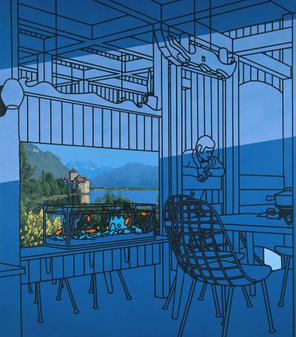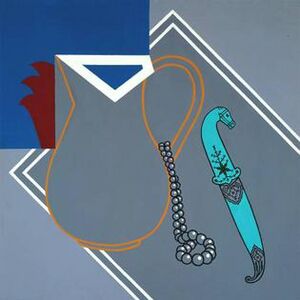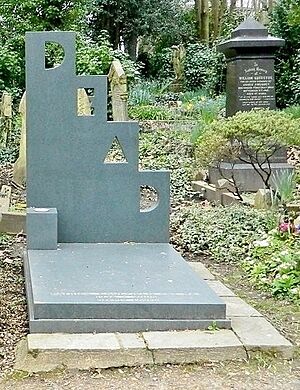Patrick Caulfield facts for kids
Quick facts for kids
Patrick Caulfield
|
|
|---|---|

After Lunch, 1975, Tate Gallery
|
|
| Born |
Patrick Joseph Caulfield
29 January 1936 |
| Died | 29 September 2005 (aged 69) London, England
|
| Education | Chelsea School of Art, 1956–1959 Royal College of Art, 1960–1963 |
| Known for | Painting, Printmaking |
|
Notable work
|
After Lunch, 1975
Still Life with Dagger, 1963 Les Demoiselles d'Avignon vues de derrière, 1999 |
| Awards | Prix des Jeunes Artistes, 1965
Royal Academician, 1993 Jerwood Painting Prize, 1995 London Institute Honorary Fellowship, 1996 Commander of the Order of the British Empire, 1996 |

Patrick Joseph Caulfield (born January 29, 1936 – died September 29, 2005) was an English painter and printmaker. He was famous for his bright, bold paintings. His art often mixed very realistic details with simple, flat backgrounds.
Caulfield's paintings usually showed a few simple objects inside a room. He often used large, flat areas of color with thick black outlines. Sometimes, a whole painting would be mostly one color.
Contents
Early Life and Art Inspiration
Patrick Joseph Caulfield was born in Acton, west London, on January 29, 1936. During World War II, his family moved to Bolton in 1945. They worked at the De Havilland factory there.
Patrick left school at 15. He first worked as a filing clerk. Later, he moved to the design studio at Crosse & Blackwell, a food company. He helped with food displays.
At 17, he joined the Royal Air Force. He was inspired by the 1952 movie Moulin Rouge, which was about the artist Henri de Toulouse-Lautrec. This movie made him want to be an artist. In his free time, he took evening art classes at Harrow School of Art.
Art Studies and Career
Patrick Caulfield studied art at Chelsea School of Art from 1956 to 1960. He won two awards that helped him travel to Greece and Crete after he finished school. His trip to Crete was very important. He found inspiration in the ancient Minoan frescoes and the island's bright colors.
From 1960 to 1963, he studied at the Royal College of Art. Other famous artists like David Hockney and Allen Jones were also studying there. After finishing his studies, Caulfield taught at Chelsea School of Art from 1963 to 1971.
In 1964, he showed his work at the New Generation exhibition in London. Because of this show, people often linked him to the pop art movement. However, Caulfield did not like this label. He saw himself as a "formal" artist, focusing on shapes and colors.
Painting Style Changes
From the mid-1970s, Patrick Caulfield started to add more realistic details to his paintings. An early example of this is his painting After Lunch (1975). Another work, Still-life: Autumn Fashion (1978), shows different styles. Some objects in it have thick black outlines and flat colors, like his earlier work. But a bowl of oysters in the same painting looks much more realistic. Other parts of the painting have looser brushstrokes.
Later in his career, Caulfield went back to his earlier, simpler painting style. He focused again on flat colors and bold outlines.
In 1987, Caulfield was nominated for the Turner Prize. This is a very important art award in the UK. In 1996, he was given the title of Commander of the Order of the British Empire (CBE) for his contributions to art.
Patrick Caulfield passed away in London in 2005. He is buried in Highgate Cemetery. His work is owned by famous collectors like Charles Saatchi and musician David Bowie. The road where he was born was even renamed Caulfield Road after his death.
Special Art Projects
Later in his career, Caulfield took on several special art projects. These were in addition to his regular paintings and prints.
- In 1990, he designed a beautiful stained glass window for The Ivy restaurant in London. You can see it from inside and outside the restaurant.
- In 1992, he designed a large, 12-meter carpet for the British Council's headquarters in Manchester.
- He also designed sets for two ballets at the Royal Opera House. These were Party Game in 1984 and Rhapsody in 1995.
- In 2001, Caulfield painted the doors of the Great West Organ at Portsmouth Cathedral.
Images for kids
-
After Lunch, 1975, Tate Gallery
-
Still Life with Dagger, 1963, Tate Gallery





